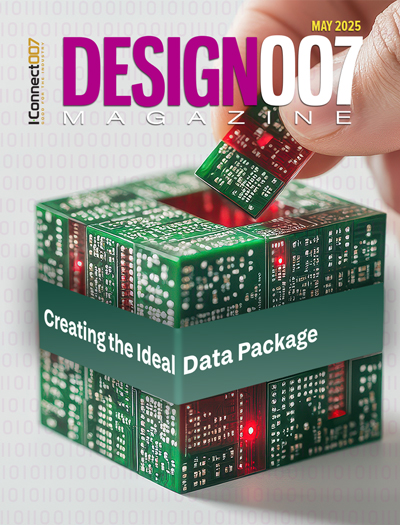-

- News
- Books
Featured Books
- design007 Magazine
Latest Issues
Current Issue
Creating the Ideal Data Package
Why is it so difficult to create the ideal data package? Many of these simple errors can be alleviated by paying attention to detail—and knowing what issues to look out for. So, this month, our experts weigh in on the best practices for creating the ideal design data package for your design.

Designing Through the Noise
Our experts discuss the constantly evolving world of RF design, including the many tradeoffs, material considerations, and design tips and techniques that designers and design engineers need to know to succeed in this high-frequency realm.

Learning to Speak ‘Fab’
Our expert contributors clear up many of the miscommunication problems between PCB designers and their fab and assembly stakeholders. As you will see, a little extra planning early in the design cycle can go a long way toward maintaining open lines of communication with the fab and assembly folks.
- Articles
- Columns
Search Console
- Links
- Media kit
||| MENU - design007 Magazine
Effective Characteristic Impedance
March 4, 2015 | Kirk Fabbri, KSPT Engineering ConsultingEstimated reading time: Less than a minute
In a typical interconnect, there lie multiple places where capacitance plays a factor in the signal integrity. This includes the driver and receiver output/input capacitance, as well as the packages, vias, and the transmission lines. Failing to optimize these parameters can often lead to unwanted reflections, excessive radiated and or conducted emissions, and sometimes failure of components and systems.
Reflections can occur anytime there is an impedance mismatch on the line. Sources of mismatches are plentiful and include trace width changes, vias, stubs, reference plane changes, and even the so-called fiber weave effect. In this case, a trace can encounter a different dielectric constant depending on whether it is routed over glass or the epoxy resin in the dielectric material.
In this investigation, it is the capacitive contribution of the different components that are of interest, and how they affect the characteristic impedance the driver sees.
To read the rest of this article, click here.
Suggested Items
Knocking Down the Bone Pile: Gold Mitigation for Class 2 Electronics
05/07/2025 | Nash Bell -- Column: Knocking Down the Bone PileIn electronic assemblies, the integrity of connections between components is paramount for ensuring reliability and performance. Gold embrittlement and dissolution are two critical phenomena that can compromise this integrity. Gold embrittlement occurs when gold diffuses into solder joints or alloys, resulting in mechanical brittleness and an increased susceptibility to cracking. Conversely, gold dissolution involves the melting away of gold into solder or metal matrices, potentially altering the electrical and mechanical properties of the joint.
Kasuo Electronics Launches Advanced Testing Laboratory to Strengthen Global Supply Chain Quality Assurance
04/29/2025 | BUSINESS WIREKasuo Electronics Co., Ltd, a globally recognized trader of electronic components, has officially operationalized its state-of-the-art testing laboratory.
QuantumScape, Murata Announce Framework for Ceramics Collaboration
04/25/2025 | BUSINESS WIREQuantumScape Corporation, a global leader in next-generation solid-state lithium-metal battery technology, and Murata Manufacturing Co. have entered into the first phase of an agreement to explore a collaboration for high-volume manufacturing of ceramic film for QS’s solid-state battery technology.
IPC Welcomes Exemptions to Reciprocal Tariffs
04/14/2025 | IPCIPC shared the following statement today on tariff exclusions and their implications on the global electronics industry. This statement can be attributed to Dr. John W. Mitchell, IPC president and CEO:
ASMPT Demonstrates Technology Leadership in SMT Assembly
04/09/2025 | ASMPTThe rapid development of artificial intelligence is driving the demand for high-performance processors and placing great demands on electronics manufacturing.


